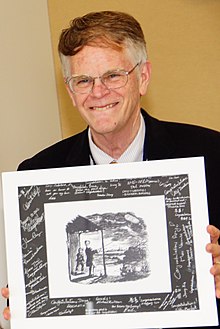Douglas C. Wallace
Douglas Cecil Wallace (born November 6, 1946 in Cumberland , Maryland ) is a geneticist and evolutionary biologist at the University of Pennsylvania and the Children's Hospital of Philadelphia in Philadelphia , Pennsylvania .
Life
Wallace earned a BA in Genetics and Developmental Biology from Cornell University in Ithaca, New York in 1968 and a Masters in Genetics and Developmental Biology from Yale University in New Haven, Connecticut, a Masters in 1972 and a Ph.D. in microbiology and human genetics . His dissertation was entitled Cytoplasmic genetics in mammalian tissue culture cells . As a postdoctoral fellow , he stayed at Yale University before becoming an assistant professor at Stanford University School of Medicine in Stanford, California in 1976 . In 1983 he became a professor (adjunct professor) of biochemistry , anthropology and pediatrics (genetics) at Emory University in Atlanta, Georgia. From 1996 to 2002, Wallace worked for the Human Genome Organization (HUGO) in the field of mitochondrial DNA . In 2002 he took over a professorship in molecular biology at the University of California in Irvine, California, and became director of the Center for Molecular and Mitochondrial Medicine and Genetics there . In 2006 he was visiting professor at the Academia Sinica in Taipei, Republic of China. 2010 joined Wallace Professor of Pathology and Laboratory Medicine and endowed professor for Mitochondrial Medicine and Metabolic Diseases at the University of Pennsylvania in Philadelphia, Pennsylvania.
Act
Wallace is recognized as a leader in mitochondrial DNA research . He introduced mitochondrial genetics into human molecular genetics . In 1975 Wallace was able to show a genetic disorder in the area of mitochondrial DNA for the first time (resistance to chloramphenicol ) or in 1990 to describe a mitochondrial mutation as the cause of a certain form of myoclonic epilepsy . Wallace was instrumental in the Mitochondrial Genome Project and developed new methods for analyzing mitochondrial DNA.
Awards (selection)
- 1995 membership in the National Academy of Sciences
- 2000 Passano Award (together with Giuseppe Attardi )
- 2004 membership in the American Academy of Arts and Sciences
- 2005 Pasarow Award
- 2009 membership in the Institute of Medicine
- 2012 Gruber Prize for Genetics
- 2017 Benjamin Franklin Medal from the Franklin Institute
- 2017 Dr. Paul Janssen Award for Biomedical Research
Web links
- Douglas C Wallace at the University of Pennsylvania (upenn.edu); Retrieved July 3, 2011
- CV at Academia Sinica (sinica.edu.tw); accessed on July 3, 2011 (PDF; 34 kB)
Individual evidence
- ↑ a b The Passano Awards 1945–2010 at passanofoundation.org; Retrieved July 3, 2011
- ↑ Book of Members 1780 – present, Chapter W. (PDF; 852 kB) In: American Academy of Arts and Sciences (amacad.org). Accessed April 7, 2018 .
- ^ IOM Class of 2009 ( Memento from July 19, 2011 in the Internet Archive )
| personal data | |
|---|---|
| SURNAME | Wallace, Douglas C. |
| ALTERNATIVE NAMES | Wallace, Douglas Cecil |
| BRIEF DESCRIPTION | American geneticist and evolutionary biologist |
| DATE OF BIRTH | November 6, 1946 |
| PLACE OF BIRTH | Cumberland, Maryland |
